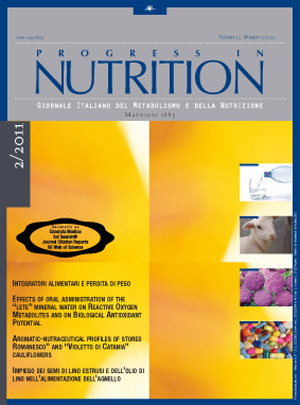Aromatic-nutraceutical profiles of stored Romanesco” and “Violetto di Catania” cauliflowers
Keywords:
Volatile substances, sulforaphane, GC/MS analysis, vitamin C, total anthocyanins, HPLC analysis, refrigerated storageAbstract
SummaryPost-harvest aromatic-nutraceutical profiles by the measure of the content of volatile substances, sulforaphane or 4-methylsulphinylbutyl NCS, vitamin C (ascorbic+ dehydroascorbic acid) and total anthocyanins were determined in “Romanesco” and “Violetto di Catania” cauliflowers (Brassica oleracea L. var. botrytis) stored at +4°C for 7-14 days. Total volatile characteristic substances after 7 days of storage were similar to the starting samples for both cauliflowers, but they decreased after 14 days. In both cauliflowers, sulforaphane was almost constant after 7 days; while then it decreased. Ascorbic acid already decreased after 7 days of storage and was constant after 14 days in both vegetables. In “Violetto di Catania”, the decrease of ascorbic acid was balanced by the presence of dehydroascorbic acid, that, despite having an hydroxyl group oxidized, is still biologically active as antioxidant molecule. Anthocyanins in “Violetto di Catania” increased after the first week of storage and then decreased after 14 days.
Profili aromatici e nutraceutici di cavolfiore “Romanesco” e “Violetto” di Catania” dopo frigoconservazione
Riassunto
È stata studiata l’influenza della conservazione a +4°C per 7-15 giorni sul profilo nutraceutico-aromatico del cavolfiore (Brassica oleracea L. var. botrytis) “Romanesco” e “Violetto di Catania”, mediante la determinazione del contenuto in sostanze volatili, sulforafane o 4-metilsulfinilbutil NCS, vitamina C (acido ascorbico + deidroascorbico) ed antociani totali. Le sostanze volatili caratteristiche totali si mantenevano simili al prodotto fresco dopo 7 giorni di conservazione in entrambe le cultivar, mentre diminuivano dopo 14 giorni. Il sulforafane mostrava un andamento simile. L’acido ascorbico diminuiva già dopo una settimana per poi mantenersi costante dopo 14 giorni per entrambe le cultivar. Nel “Violetto di Catania” la perdita in acido ascorbico era bilanciata dalla presenza di acido deidroascorbico che, nonostante abbia un gruppo ossidrilico ossidato, presenta ancora attività biologica come antiossidante. Le antocianine nel “Violetto di Catania” aumentavano nella prima settimana di conservazione per poi diminuire durante la seconda.
Downloads
Published
Issue
Section
License
This is an Open Access article distributed under the terms of the Creative Commons Attribution License (https://creativecommons.org/licenses/by-nc/4.0) which permits unrestricted use, distribution, and reproduction in any medium, provided the original work is properly cited.
Transfer of Copyright and Permission to Reproduce Parts of Published Papers.
Authors retain the copyright for their published work. No formal permission will be required to reproduce parts (tables or illustrations) of published papers, provided the source is quoted appropriately and reproduction has no commercial intent. Reproductions with commercial intent will require written permission and payment of royalties.

This work is licensed under a Creative Commons Attribution-NonCommercial 4.0 International License.


